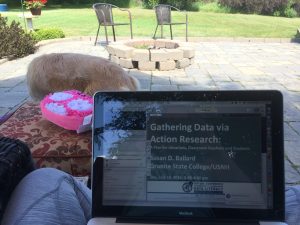
Virtual PD on my patio
One day over the summer, I was scrolling through Twitter and saw a post for the 4T Virtual Conference on Data Literacy. As someone who has presented at the 4T Virtual Conference on Digital Writing, I couldn’t believe that I hadn’t heard of the data literacy arm–and it was coming up in two days! I quickly clicked the link and signed myself up, ready for two days’ worth of virtual PD about teaching students data literacy, and which I could access from my patio.
If you’ve never attended a virtual conference, they tend to work like this: once you sign up, you are sent a link to a virtual room, which you enter a few minutes before the session is slated to begin. Generally, there is some kind of introductory task that allows people to get to know one another. This task also allows a moderator to introduce the presenter and troubleshoot along the way.
Whatever the presenter is talking about is the main reason people attend the session. But the running chat (which move so fast!) among all of the participants often yield tons of great, practical ideas for teachers, too.
The Info on Infographics
I attended multiple sessions, on topics ranging from an introduction to data literacy, to data literacy in the content areas, to action research in the classroom. For this conference, I was most looking forward to the sessions about data visualization and infographics, though. I’ve dabbled with making infographics and have always wanted to have students create them, but I was never sure how to go about doing that, because I didn’t feel that I had a design background.
As the presenters were speaking, something that one of them said really struck me: think of an infographic like an argumentative essay. The infographic itself is the overall argument. The images, design, and information are the evidence and reasons.
Thinking about infographics in this way was like a light bulb going off in my head. Writing arguments with supporting evidence is something students are well versed in, and moving from a traditional essay to a different argumentative form seemed like a great next step.
Get Visual
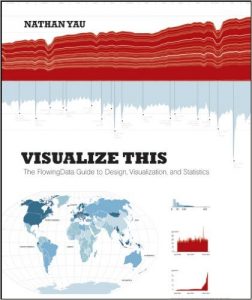 In addition to seeing infographics in a new light, I also learned, from participants in the chat, about two books that would expand my understanding of data visualizations. The books are Visualize This: The FlowingData Guide to Design, Visualization, and Statistics and Data Points: Visualization that Means Something, both by Nathan Yau. While the books are sometimes heavy on programming language, they greatly enhanced my understanding of how data might be visualized, and why you might visualize a particular data set. They also offered tons of practical (and often free) resources for visualizing data.
In addition to seeing infographics in a new light, I also learned, from participants in the chat, about two books that would expand my understanding of data visualizations. The books are Visualize This: The FlowingData Guide to Design, Visualization, and Statistics and Data Points: Visualization that Means Something, both by Nathan Yau. While the books are sometimes heavy on programming language, they greatly enhanced my understanding of how data might be visualized, and why you might visualize a particular data set. They also offered tons of practical (and often free) resources for visualizing data.
As I was reading these books over the summer, I had planned on using with students what I learned. But now that I have moved into the role of curriculum coordinator, I know this learning will be very applicable to my new work.
 Jianna Taylor (@JiannaTaylor) is the ELA/SS Curriculum Coordinator for the West Bloomfield School District. Prior to this role, she was a middle school ELA and Title 1 teacher. She is a MiELA Network Summer Institute facilitator and member of the OWP Core Leadership Team. Jianna earned her bachelor’s degree from Oakland University and her master’s degree from the University of Michigan. She also writes reviews of children’s books and young adult novels for the magazine School Library Connection.
Jianna Taylor (@JiannaTaylor) is the ELA/SS Curriculum Coordinator for the West Bloomfield School District. Prior to this role, she was a middle school ELA and Title 1 teacher. She is a MiELA Network Summer Institute facilitator and member of the OWP Core Leadership Team. Jianna earned her bachelor’s degree from Oakland University and her master’s degree from the University of Michigan. She also writes reviews of children’s books and young adult novels for the magazine School Library Connection.

 It’s been a couple of weeks since school let out for the summer. I’ve tackled a few projects, read a book or two. And so, of course, I’ve started to think about next year.
It’s been a couple of weeks since school let out for the summer. I’ve tackled a few projects, read a book or two. And so, of course, I’ve started to think about next year.  Two years ago my students really dug into Ceremony, by Leslie Marmon Silko. It was the most discussed novel, followed by Atwood’s The Handmaid’s Tale. Not so this year. Ceremony was roundly criticized by almost all of my students, while Handmaid’s was lauded.
Two years ago my students really dug into Ceremony, by Leslie Marmon Silko. It was the most discussed novel, followed by Atwood’s The Handmaid’s Tale. Not so this year. Ceremony was roundly criticized by almost all of my students, while Handmaid’s was lauded. Rick Kreinbring teaches English at Avondale High School in Auburn Hills, Michigan. His current assignments include teaching AP Language and Composition and AP Literature and Composition. He is a member of a
Rick Kreinbring teaches English at Avondale High School in Auburn Hills, Michigan. His current assignments include teaching AP Language and Composition and AP Literature and Composition. He is a member of a  When May comes, and the green starts to overtake the landscape, and the
When May comes, and the green starts to overtake the landscape, and the  I would have the students keep the envelopes open, so that I could “grade” them and also screen for any letter of bad intent (only one or two in the many years did this, but I’m glad I checked in the end).
I would have the students keep the envelopes open, so that I could “grade” them and also screen for any letter of bad intent (only one or two in the many years did this, but I’m glad I checked in the end). Caroline Thompson (
Caroline Thompson ( When I think back about why I wanted to become a teacher, I remember an ambition I had to make a difference in the lives of others. A want to share my passion for the books that I loved. A desire to help people express themselves in new and powerful ways. These are ideals that I still hold after twelve years of teaching, amid different political landscapes and ever-changing initiatives.
When I think back about why I wanted to become a teacher, I remember an ambition I had to make a difference in the lives of others. A want to share my passion for the books that I loved. A desire to help people express themselves in new and powerful ways. These are ideals that I still hold after twelve years of teaching, amid different political landscapes and ever-changing initiatives. Recognizing, naming, and even copying good writing are all important pieces in the quest to shape good writers.
Recognizing, naming, and even copying good writing are all important pieces in the quest to shape good writers.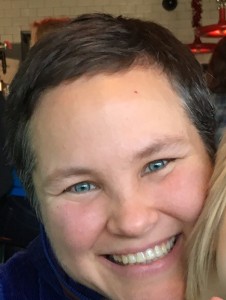 Caroline Thompson (
Caroline Thompson ( Secondary teachers continue to switch from old units designed around novels, to new Common Core State Standards units focused on skills and genres. As they do so, an instructional method that can support this shift is the use of mentor texts to “read like a writer.”
Secondary teachers continue to switch from old units designed around novels, to new Common Core State Standards units focused on skills and genres. As they do so, an instructional method that can support this shift is the use of mentor texts to “read like a writer.”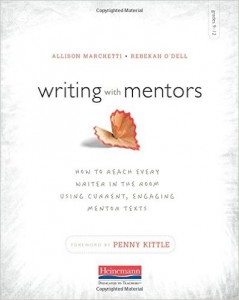 That’s why it’s so exciting to see the recent publication of
That’s why it’s so exciting to see the recent publication of 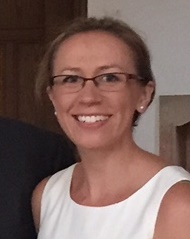 Megan Kortlandt (
Megan Kortlandt (
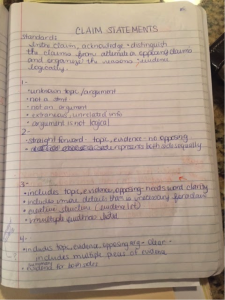
 Amy Gurney is an 8th grade Language Arts teacher for Bloomfield Hills School District. She was a facilitator for the release of the
Amy Gurney is an 8th grade Language Arts teacher for Bloomfield Hills School District. She was a facilitator for the release of the 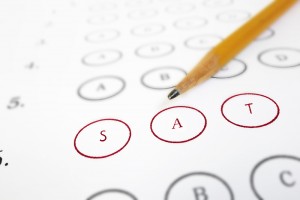 I don’t know about you, but when I got my first look at a sample SAT essay prompt, my eyes just about bugged out of my head.
I don’t know about you, but when I got my first look at a sample SAT essay prompt, my eyes just about bugged out of my head. I kept coming back to the portion of the essay that asks students for analysis. At first, I wondered if we could put together a toolbox of the most common ways of building an argument, or a list of a few “magic” rhetorical devices students could expect to encounter. But the more I read and explored, the more I came back to the answer that no, there would be no magic lists or silver bullets for this test. What the analysis portion essentially boils down to is: Can students understand what an author’s purpose is, and analyze the moves the author made to achieve that purpose? This isn’t a test prep strategy; it’s just what good readers and writers can do!
I kept coming back to the portion of the essay that asks students for analysis. At first, I wondered if we could put together a toolbox of the most common ways of building an argument, or a list of a few “magic” rhetorical devices students could expect to encounter. But the more I read and explored, the more I came back to the answer that no, there would be no magic lists or silver bullets for this test. What the analysis portion essentially boils down to is: Can students understand what an author’s purpose is, and analyze the moves the author made to achieve that purpose? This isn’t a test prep strategy; it’s just what good readers and writers can do! As 2015 came to a close and winter break was upon us, I had some time to reflect upon my teaching practice, as I planned for my next units of study. I remembered how, at the beginning of the year, we received from our Literacy Specialist an immersion packet. The packet suggested several teacher-written pieces, which would go along with the units from Atlas.
As 2015 came to a close and winter break was upon us, I had some time to reflect upon my teaching practice, as I planned for my next units of study. I remembered how, at the beginning of the year, we received from our Literacy Specialist an immersion packet. The packet suggested several teacher-written pieces, which would go along with the units from Atlas.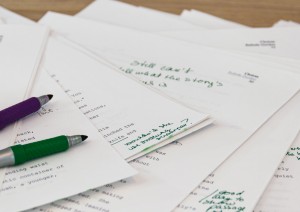 After I submit my pieces, our editor does his thing, which means inevitable changes to sentence structure, word choice, and sometimes even titles. I have to admit, it can be hard to take at times. This made me realize that I need to be more gentle in my approach with my students; more conversation needs to happen as I go through their pieces. It also made me realize how shared writing, revising and editing can help my students achieve better results.
After I submit my pieces, our editor does his thing, which means inevitable changes to sentence structure, word choice, and sometimes even titles. I have to admit, it can be hard to take at times. This made me realize that I need to be more gentle in my approach with my students; more conversation needs to happen as I go through their pieces. It also made me realize how shared writing, revising and editing can help my students achieve better results. Beth Rogers is a fifth grade teacher for
Beth Rogers is a fifth grade teacher for